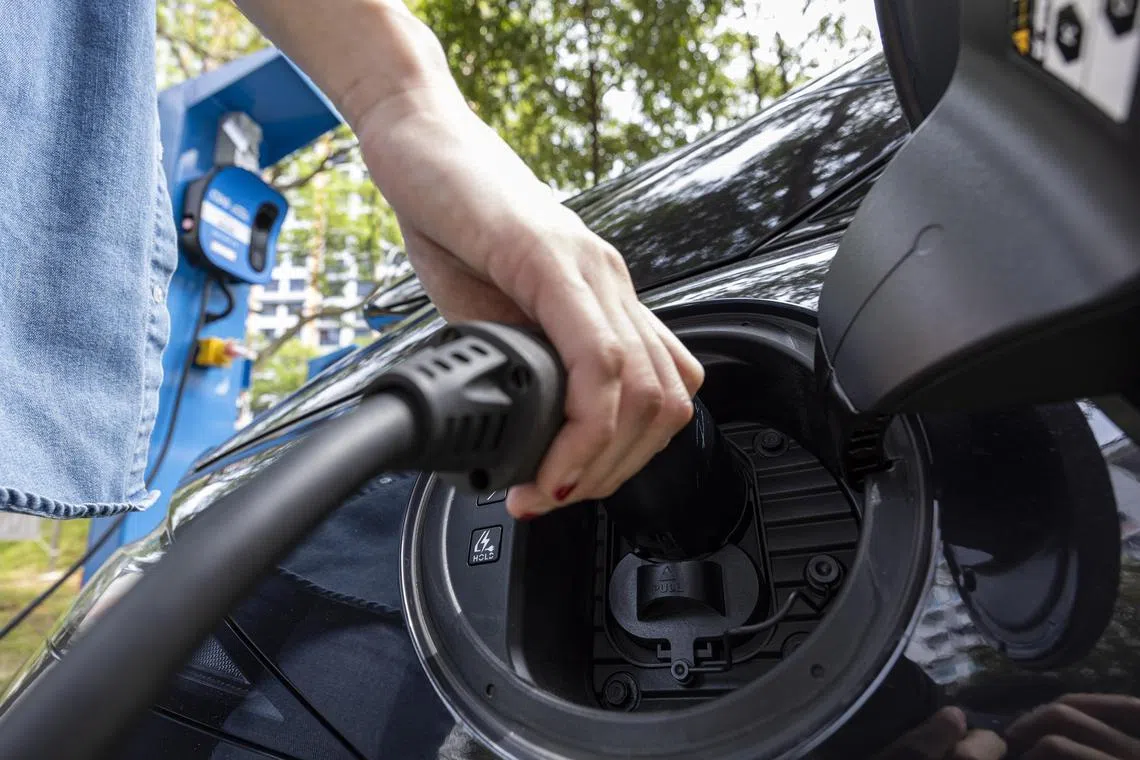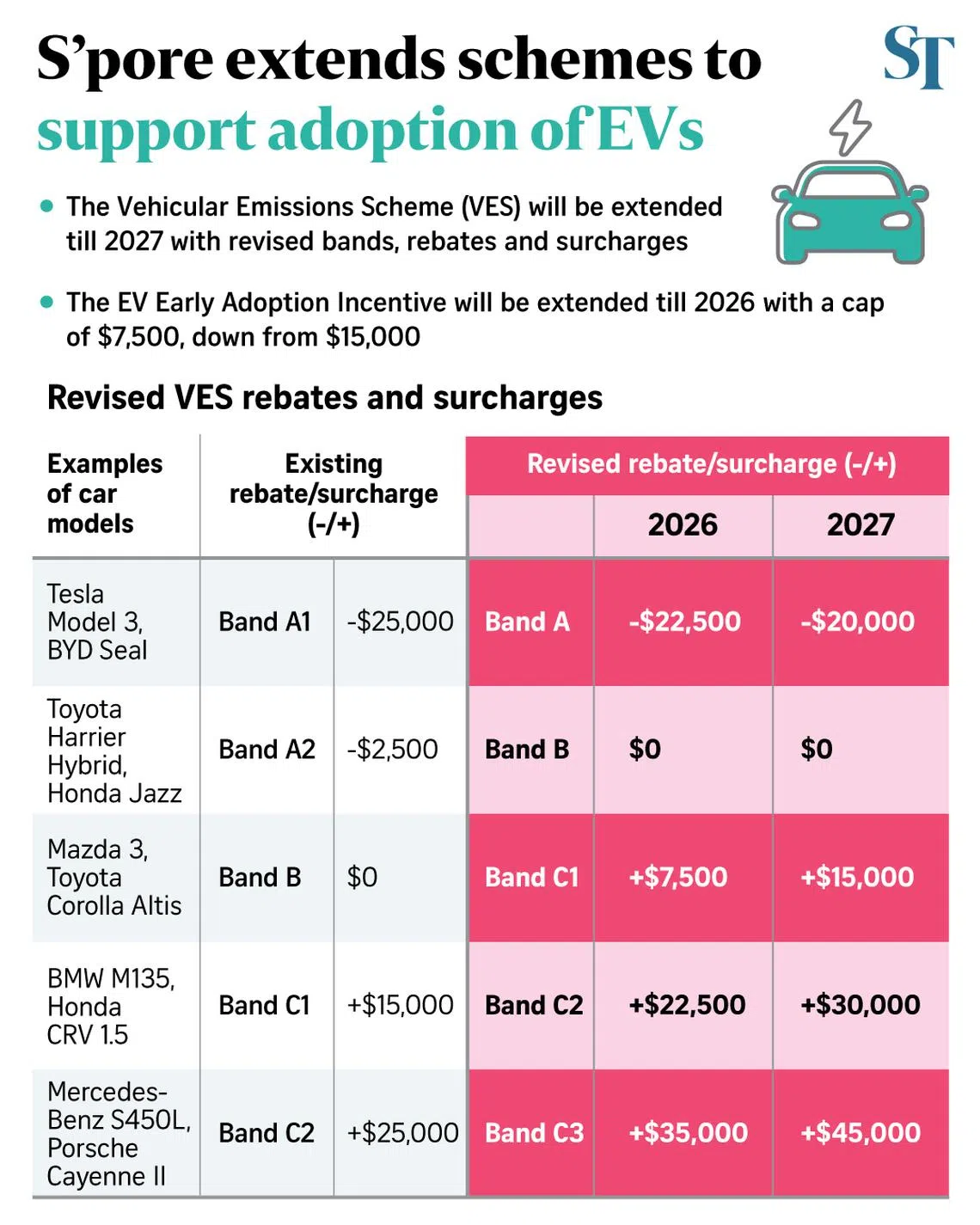Govt extends vehicle schemes to increase adoption of EVs; hybrids will no longer get rebates
Sign up now: Get ST's newsletters delivered to your inbox

Prior to the extension, the two schemes were due to expire in 2025.
ST PHOTO: BRIAN TEO
Follow topic:
- From 2026, EV rebates will decrease: the maximum combined rebate from EEAI and VES will be $30,000, and petrol hybrids get no VES rebates.
- VES surcharges for high-emission vehicles will increase to $35,000 in 2026 and $45,000 in 2027, while EEAI will be discontinued in 2027.
- LTA cites increased EV adoption and narrowing cost gaps as reasons for revisions, aiming for 100 per cent cleaner energy vehicles by 2040.
AI generated
SINGAPORE – Two schemes to encourage the adoption of electric vehicles (EVs) have been extended and revised to provide lower rebates.
The Vehicular Emissions Scheme (VES), which is meant to nudge drivers into opting for cars with lower emissions, will be extended for two years from Jan 1, 2026, to Dec 31, 2027. The scheme’s criteria will be tightened, with petrol hybrid cars no longer getting any rebates.
Surcharges will be raised for cars with high exhaust emissions. Those that fall into the most polluting banding under the VES will incur a surcharge of $35,000 in 2026, up from $25,000 currently. In 2027, the surcharge will be raised to $45,000.
Separately, the EV Early Adoption Incentive (EEAI)
The rebate provided under this scheme will be halved from $15,000 to $7,500.
This means that from Jan 1, 2026, the maximum combined rebate for EV buyers from both schemes will be $30,000, down from the current $40,000. This will drop to $20,000 in 2027, after the early adoption incentive ends.
Motor dealers expect buyers to rush to beat the deadline for the current incentives following the announcement, with some predicting new records for certificate of entitlement (COE) premiums before the end of 2025.
In their joint statement, LTA and NEA said: “We expect a short-term increase in COE prices. Potential car buyers are strongly encouraged to be prudent in bidding for COEs.”
The authorities said the adoption of cleaner-energy vehicles, which cover EVs and hybrids, has been rising. Such vehicles accounted for 80 per cent of new car registrations made between January and August, and EVs made up half of that figure.
The revisions are driven by the increased adoption of EVs and the narrowing gap between the upfront cost of electric cars and petrol-engine cars, the agencies added.
“The overall benefits will continue to be tapered as Singapore gets closer to 100 per cent cleaner-energy vehicles by 2040, in support of our national target to achieve net-zero emissions by 2050,” the authorities said.
This marks the second revision to the EEAI since it was introduced in 2021 with up to $20,000 in tax rebate for EVs. The amount was reduced to $15,000 for the 2024-to-2025 period, and will be cut to $7,500 in 2026 before it is removed.

The VES began in 2018 to encourage buyers to choose lower-emission cars. In its current iteration, which expires on Dec 31, 2025, rebates for vehicles range from $2,500 for hybrids to up to $25,000 for EVs, while the surcharge for high-emission vehicles go up to $25,000.
Both VES and EEAI rebates are given when a new car is registered, offsetting the price for the consumer.
Associate Professor Walter Theseira from the Singapore University of Social Sciences said the reduction in EV subsidies is expected as they were given initially to help offset the higher upfront cost associated with the technology.
It also makes sense to cut back now, said Prof Theseira, given the sales success of Chinese EV brands. So far in 2025, Chinese EV brand BYD is registering more cars than any other brand in Singapore.
He added: “It is clear that EV subsidies are not needed in full force when you have Chinese carmakers being able to sell vehicles at more competitive prices and with better features than cars with combustion engines.”
As for the increasingly punitive surcharges slapped on combustion engine cars, Prof Theseira said the VES has been based on gradually increasing the pressure on combustion engine cars to make them less attractive.
Dr Zafar Momin, an adjunct professor at the NUS Business School, said the reduced incentives reflect the Government’s confidence that demand for EVs will continue to grow.
“As battery prices continue to go down, EV prices may go down anyway,” he added.
In its Global EV Outlook 2025 report, the International Energy Agency, a Paris-based inter-government agency, reported that the global average price of battery packs fell more than 25 per cent in 2024 compared with 2023.
The report noted that other factors in manufacturing and the carmakers’ business strategy also influence EV prices.
Dr Momin said that for Singapore to achieve its goal of having only cleaner-energy vehicles by 2040, petrol engine cars must become less attractive – hence the rising surcharge imposed on such cars from 2026.

